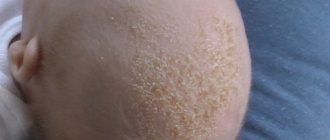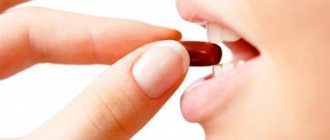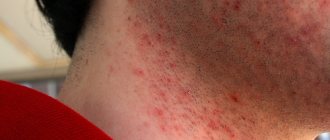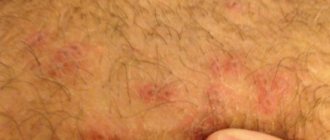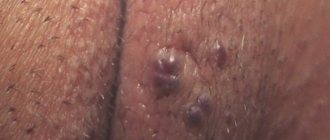Pimples on the scalp in the hair are a very common occurrence. Unfortunately, it is usually not given importance, since the rashes are hidden behind the strands. As a rule, the patient turns to a specialist only when the problem becomes widespread. However, it should be remembered that treatment in this case turns out to be much more complex and lengthy.
Symptoms
The development of acne on the head occurs according to the following mechanism:
- Severe itching, discomfort, which forms even before acne appears;
- Formation of an inflammatory process with a red border, but small in size;
- Pain when pressed;
- Gradual filling of the cavity with pus;
- Independently for opening the abscess for 5-6 days.
As soon as the abscess has disappeared on its own, it is necessary to disinfect the damaged area. To do this, you can use hydrogen peroxide, Chlorhexidine, and other antiseptics.
Pimples can only start on the scalp. But gradually they move to other areas of the body. For example, neck, upper back, temples and face. To prevent this, it is recommended to promptly identify the cause of the condition and begin treatment prescribed by a dermatologist.
If the purulent contents of the pimple have penetrated to the deep layers of the epidermis, after opening and healing, a connective tissue scar is formed.
Prevention
To prevent the appearance of acne on the scalp, it is recommended to follow these prevention rules:
- Do not wash your hair too often - once every few days.
- Choose the right hair care products and shampoo.
- Lead a healthy lifestyle - do not drink alcohol, do not smoke, eat right.
- Avoid stressful situations.
- Do not squeeze out pimples that appear.
- Change bedding regularly - this should be done at least once a week.
- Do not use other people's combs or other personal products.
Causes of acne formation
Physiological changes and pathological processes can occur in the body, which lead to the formation of pimples. All of them are listed in the table.
| Causes | Description |
| Use of low-quality cosmetics and hygiene products | Often, low-quality shampoo leads to profuse rashes all over the body. Pimples form and gradually begin to enlarge. Dermatologists advise choosing a cosmetic product without dyes, preservatives, sulfates, parabens and other harmful substances. Additionally, this leads to intoxication and dry skin. |
| Poor nutrition | It is important that the body receives a large amount of vitamins, microelements and minerals. If they are concentrated in a small volume or completely absent, electrolyte imbalance and hypovitaminosis occurs. This leads to deterioration in the quality of hair, nails, and skin. Pimples form on the epidermis |
| Stress | If a person is subject to nervous tension, stress, depression, neurosis for a long time, this negatively affects the body. A large number of hormones are released, overwork is formed. The patient is characterized by increased sweating and activation of the sebaceous glands. Pores become clogged and ulcers form |
| Taking medications | Some medications have a negative reaction for the human body. They cause side effects. For example, hormones, antibiotics, anabolics, barbiturates. During the course of treatment, a purulent formation is formed, which gradually increases in size and spreads over the upper part of the body, including the head. |
| Bad habits | Frequent consumption of alcohol and prolonged smoking negatively affect not only the respiratory tract, but also the epidermis. Most patients with bad habits have profuse rashes containing pus |
| Poor quality clothes | If a patient wears underwear, clothes, or hats with a high synthetic content, this negatively affects the condition of the skin. She begins to sweat a lot and sebum is produced. It accumulates in the pores, and pathogenic microflora begins to multiply. Therefore, it is recommended to use only clothes with natural composition |
| Hypothermia | If a person is not dressed appropriately for the weather during a cold period, hypothermia may develop. This is especially true for patients who do not have hats. This has a negative effect on the epidermis, it becomes excessively cold, dries, flakes, and pimples appear on it. |
Women experience frequent changes in hormone levels. Therefore, rashes appear more often on their body, including on the head and face.
Tests and diagnostics
To establish the cause of the disease and eliminate it, the doctor performs an examination and laboratory analysis.
- Initially, the specialist examines the scalp and determines the nature of the formations and their features. It is important to collect anamnesis and question the patient about his habits, diet, etc.
- hormone analysis .
- Scalp scrapings are also examined for the presence of bacterial and fungal cultures.
- If necessary, a stool examination is prescribed to determine the state of microflora .
- Also, if necessary, ultrasound or other studies are performed.
Pathological causes
There are biological reasons that can cause excessively large ulcers to form that require treatment from the inside:
- hypersecretion of sebum, clogging pores, which causes inflammatory processes;
- polycystic ovary syndrome, which causes sudden hormonal changes;
- pathologies of the adrenal glands;
- dysfunction of the immune system with a sharp increase in the number of viruses and bacteria in the body;
- chronic infectious process.
Most often, the functioning of the sebaceous glands becomes difficult. This leads to excessive production of sebum, which spreads to the supports and clogs them. A large number of pathogenic microflora multiply in this area, which leads to an active inflammatory process. Therefore, pimples become larger and hurt a lot. Sebum often accumulates in the hair growth area on the head. As soon as the pimple bursts, the purulent contents come out, and the pimple begins to heal. But in its place a scar forms.
Women often experience hormonal changes not only due to diseases, but also physiological changes:
- onset of menstruation;
- adolescence;
- birth of a child;
- menopause
In a woman’s body, not only changes in the levels of progesterone, estrogen and testosterone occur. All this leads to sudden changes in hormonal levels, which causes an increase in the number of acne. A similar mechanism develops due to dysfunction of the adrenal glands.
Pathogenic microflora can multiply in the head area. It is constantly there, but is activated under the influence of negative factors. For example, using low-quality shampoo. The microbe multiplies, clogs the hair follicle, and leads to suppuration.
If pimples continue to spread even after purchasing a good shampoo, it is better to consult a dermatologist.
Classification
There are 2 main types of acne on the head:
- Comedones
. These are blackheads that clog the pores. They become very inflamed, forming a pain syndrome. Comedones are difficult to notice under the hair, so they continue to spread. - Inflamed acne
. These are also acne prone to inflammation. But in the center they are white, redness is observed only at the edges.
It is important not to confuse purulent formation with wen, which are formed due to changes in metabolism and other processes.
Kinds
In medical practice, in fact, there is no special division of acne in the hair. But, to make it more convenient to select treatment options, they are conventionally divided into two types:
- Comedones are simple acne rashes, the appearance of which can be caused by blockage of the sebaceous ducts or their contamination. This rash is not prone to inflammation and does not cause discomfort to a person. There is such a type of comedones as closed ones. As a rule, they form deep in the layers of the skin and also do not cause any particular inconvenience, although they can be felt.
- Acne accompanied by inflammatory processes. They are characterized by reddened areas and a white protruding rod in the center.
How to get rid of acne quickly
Acne is a common skin problem, affecting about 85 percent of the population.
In addition, rashes are divided into such types of acne as:
- Purulent ones are tubercles with pus inside. This sign indicates inflammation caused by a bacterial infection. If the amount of rash is small, it indicates a superficial lesion. In case of complications, the inflammatory process affects the entire hair follicle, the pimples are large and tend to merge with each other.
- Red is the initial stage of inflammation caused by pathogenic microorganisms. After a couple of days, they transform into pustular formations. In this case, infection by a herpes virus also cannot be ruled out.
- Painful - often such a rash is accompanied by pain, the intensity of which can determine the depth of the lesion, as well as the severity of the disease. If the process is also accompanied by itching, and the pain extends beyond the boundaries of the affected area, then the development of shingles cannot be ruled out in this case.
In situations where the rash is caused by a herpes virus infection, the pimples constantly itch and form into numerous red blisters.
Therapy options
When pimples appear, go for a consultation with a dermatologist. He makes a diagnosis using the following methods:
- initial examination;
- bacteriological culture;
- general blood and urine tests.
If systemic diseases are detected, additional consultation with specialists is required. For example, neurologist, allergist, endocrinologist.
Once the root cause is determined, the patient is given treatment instructions:
- applying hygiene rules, using only high-quality cosmetics, including scalp and hair care;
- following a special diet that normalizes metabolism, improves intestinal activity, and saturates the body with useful substances;
- local or oral administration of antibiotics to eliminate pathogenic microflora;
- antifungal medications, if the internal contents of acne are filled with fungal microflora;
- antihistamines to reduce swelling and inflammation;
- hormones that normalize endocrine levels.
To improve the condition of skin, hair and nails, it is recommended to take multivitamin preparations.
It is important to treat the body’s condition not only from the inside, but also from the outside. Therefore, the following types of local remedies are used:
- Ichthyol ointment
- has an antiseptic, anti-inflammatory, drying effect, effectively eliminates all types of pimples; - Salicylic acid
, other alcohol tinctures - antiseptic, anti-inflammatory effect.
It is recommended to use alcohol tinctures only on the recommendation of a doctor, with great caution. Otherwise you may cause harm. The skin will become dry or burnt.
Clindovit® gel – a cure for acne
For mild to moderate acne, a dermatologist may recommend topical antibiotics such as clindamycin18.
Clindovit® gel is a medicinal product whose main active ingredient is clindamycin phosphate6. It is recommended to use it twice a day, applying it to dry, previously cleansed skin6. In order to reduce the risk of developing antibiotic resistance, it is recommended to use Clindovit® gel together with azelaic acid (for example, Azelik® gel) or benzoyl peroxide28.
*acne
Treatment methods
Acne appears due to the formation of a superficial or internal pathological process. Depending on the identification of the root cause, different types of drugs are recommended that can be used in combination.
- Antibiotics
. Use local products with an antibacterial component to destroy pathogenic microflora on the surface and inside the pimple. - Ichthyol ointment
. Eliminates purulent contents, dries, reduces inflammatory processes on the skin. - Salicylic alcohol
. Disinfects the skin area, reduces and gradually eliminates pimples. It must be used with caution so as not to harm the epidermis or cause burns. - Tar soap
. Has antiseptic properties, destroys bacteria and fungi. Often used as an additive to shampoo. - Oral antibiotics
. They are required in severe cases when there is an infection system in the human body, so an additional symptom occurs in the form of acne. Ceftriaxone, Amoxicillin, Sumamed are recommended. But they additionally use probiotics to prevent an imbalance of intestinal microflora. - Ultraviolet treatment
. Typically used in beauty salons. Under the influence of rays, all pathogenic microflora on the skin and mucous membranes die.
If there are rashes or ulcers on the skin, immediate treatment is required. This is not only a cosmetic defect, but also a risk of developing various internal diseases. Therefore, it is better to make a preliminary diagnosis, and only then begin treatment.
Diet
Diet for acne
- Efficacy: therapeutic effect after 21-30 days
- Terms: 6-8 months
- Cost of products: 1700-1800 rubles. in Week
The healthiest diet should be ensured, and the food should fully satisfy the body's need for essential vitamins and minerals. To normalize the condition of the skin, it is important to provide sufficient amounts of the following vitamins:
- Vitamin C - found in citrus fruits, black currants, sauerkraut, and onions.
- B vitamins – sea fish, tomatoes, bananas, nuts, mushrooms, cabbage, buckwheat.
- Vitamin E – milk, nuts, fish.
- Vitamin A – carrots, eggs, apricot, parsley.
- Vitamin D – butter, cod liver, seaweed, eggs.
- Vitamin K - chicken, eggs, fish.
Also, the diet must include porridge, dairy products, dried fruits, fresh vegetables and fruits.
The amount of fatty foods, alcohol, salty foods, confectionery products, and smoked foods should be minimized. It is not recommended to drink a lot of coffee and strong tea.






